Monday, July 3, 2023
Matcha Almond Pancakes, 抹茶アーモンドパンケーキ
They were quite good. We had this as a breakfast sitting outside on the patio with a cup of cappuccino and mango yogurt made with home-made yogurt with pureed and small cubes of champagne mango mixed in. These pancakes reminded us of the “Matcha green tea cake” we made a few times before.
Ingredients: (The original recipe indicated it makes 8 pancakes but we doubled the recipe and got only 7 pancakes)
1/2 cup plus 1 tablespoon (68 grams) whole-wheat pastry flour or all-purpose flour
1/2 cup (60 grams) almond flour
2 teaspoons baking powder
1/4 teaspoon fine salt
1 tablespoon matcha
1 cup (240 milliliters) whole, reduced-fat or plant-based milk
1 large egg
1 tablespoon neutral oil, such as avocado or canola
2 teaspoons vanilla extract
Maple syrup, for serving
Directions:
In a medium bowl, thoroughly whisk together the pastry flour, almond flour, baking powder and salt until combined. Sift the matcha into the mixture and whisk again to thoroughly combine.
In another medium bowl, whisk together the milk, egg, oil and vanilla until combined. Add the milk mixture to the flour mixture and stir just to combine. Do not overmix; it’s okay if there are some small lumps. Let the batter hydrate for 5 to 10 minutes. (The batter will initially appear quite watery but over the 5 to 10 minutes the flours thoroughly hydrate and it becomes thicker. Nonetheless it was still runnier than our usual pancake batters.)
Heat a large nonstick skillet or griddle over medium-high heat until hot. (To test, drop a dime-size amount of batter into the skillet and if it starts to bubble and brown right away, the pan is ready.)
Working in batches as necessary ladle the batter onto the skillet. Cook until bubbles form on top and the underside is nicely browned, about 2 minutes, then flip and cook until browned on the other side, and cooked through, 2 minutes more. Adjust the heat as necessary to prevent the pancakes from browning too fast before they’re cooked through. Transfer the pancakes to a plate and repeat with the remaining batter.
Serve with maple syrup.
These pancakes were quite good but not great. They were fairly thin in texture. The macha flavor really came through though. They reminded us of the macha cake we made previously. Next time we want a macha pancake we will try just adding some macha to our favorite buttermilk pancake recipe.
Addendum:Culinary grade vs. drinking/sipping matcha:
We have taste tested “Culinary” and “Drinking” grade matcha. Since we are not connoisseurs of matcha, we could not tell the difference. We bought the large can of “culinary matcha” from “Matcha Love” which is run by a Japanese tea company called “Ito-en” 伊藤園. For this type of cooking, this is quite good and reasonably priced.
Monday, April 10, 2023
Firefly Squid Scallion Pancake ホタルイカ入りネギ焼き
Ingredients (make 4 pancakes)
12 firefly squids (3 per pancake) or more if you like
50 grams grated nagaimo (mine was near 80 grams)
9 tbs chopped scallion (I used 5 stalks)
1 egg (I used 2 eggs)
2 tbs AP flour
1 tsp granulated bonito dashi (I used “Hondashi”ほんだし)
1 tsp soy sauce
1 tbs vegetable oil
Directions:
Since I was using more grated nagaimo than the amount called for in the original recipe, I changed the amount of eggs as a binder. I did not add the firefly squid into the batter initially. I divided the batter into 4 portions and added 3 squid to each batch.
I heated up a non-stick frying pan on medium heat and added the oil. I poured in 4 potions as seen below.
After a few minutes or when the bottoms are set and brown, I flipped the pancakes and lowered the heat and continued cooking for another 2-3 minutes or until the center was done.
Friday, June 18, 2021
Crumpet version 2 クランペット 第二弾
The new recipe had instructions as to how to control the heat to develop multiple holes as shown in the second and third pictures. You can see that while cooking, bubbles developed and then popped creating nice holes.
300 g. (2 cups) AP flour
400 ml. (1 1/2 cups) warm water
1 tsp. Salt
1 tsp. Sugar
2 tsp. Baking powder (The recipe said baking soda doesn’t work as well)
2 tsp yeast
2 tbs. warm water
1 1/2 tsp. Salt
2 tsp. Sugar
3 tsp. Baking powder (The recipe said baking soda doesn’t work as well)
3 tsp yeast
3 tbs. warm water
600 g. (4 cups) AP flour (or 2 cups AP and 2 cups + 1/4 cup Cake flour)
800 ml. (3 cups) warm water (or buttermilk or regular milk)
2 tsp. Salt
2 tsp. Sugar
4 tsp. Baking powder (The recipe said baking soda doesn’t work as well)
4 tsp yeast
4 tbs. warm water (1/4 cup)
Directions:
Bloom the yeast in the warm water. Put the flour, water and salt in the bowl of an electric mixer and beat on speed 5 for 1 minute until smooth paste forms. Add the yeast mixture, sugar and baking powder and mix on speed 5 for another 30 seconds. Cover with cling wrap and put in a warm place for 15 to 30 minutes. The surface should get foamy but it will only increase in volume by 10 to 15 %.
These crumpets were much better than the first batch we made. They got even better after the second day. We tasted them just out of the pan and the outside was crunchy but the inside was kind of wet and doughy. We initially thought they may not have been cooked through. But by the next day the insides had firmed up and were nicely chewy. The flavor was nicely accented with the taste of browned butter. We toasted them in the toaster oven and served them with melted butter and some honey. Mighty fine!
Sunday, June 6, 2021
Raised Buckwheat Blini cooked in a “platar”
Ingredients:
For Blini (makes about 21 blini)
1 1/2 cup milk
4 Tbs. (1/2 stick) butter
2 tsp. yeast
2/3 cup AP flour
2/3 cup buckwheat flour
2 Tbs. sugar
1 tsp. salt
3 large eggs, lightly beaten
For Blini (recipe X2) (mix in the 6 cup pyrex mixing cup so the batter can be poured rather than scooped into the cooking cups.)
3 cup milk
4 tsp. yeast
1 1/3 cup AP flour
1 1/3 cup buckwheat flour
4 Tbs. sugar
2 tsp. salt
6 large eggs, lightly beaten
For topping (everything is to taste and depends on the number of pancakes being served. Also anything can be used. This is just what we came up with.)
sour cream (to taste)
2 eggs, scrambled
1 Tbs. Ikura (salmon eggs) or caviar
Chives finely chopped
Directions:
For the Blini: Melt the butter in the milk. Let it cool to about 105 to 115 degrees. Mix the dry ingredients (yeast through salt) in another bowl. Pour the cooled milk mixture over the dry ingredients mixing until just combined. Cover the bowl with plastic wrap and let it rise in a warm place until doubled in volume (about 1 hour) (#1 in the 3rd group of pictures). Once it has risen either make the pancakes immediately or refridgerate covered for up to 24 hours. (We made the batter after dinner and refridgerated it over night). If refridgerated let it stand at room temperature for 20 minutes (#2). Then deflate the batter and whisk in the eggs lightly beaten.
Now, I am providing the details of how I cooked blini in the platar. This is for our future reference because this requires some finesse. First, I took out the planar and washed it with hot water (no soap), dried it by heating it on the stove and coated each of the 7 wells with olive oil using a paper towel (#3). I preheated the pan on low flame for 5 minutes then used a small ladle (second smallest ice cream scoop) add the batter, half filling the wells (#4). I continued to cook until the surface of the pancake showed bubbles and looked dry (5-7 minutes). Then came the challenge of flipping them. According to my wife, the directions in the JOC said flip the pancakes over using a skewer. But that proved entirely too simplistic. After some experimentation I came up with a method of loosening the blini by running the tip of a dinner knife around the perimeter of the well, then inserting the knife tip under the bottom of the blini to pry it loose. Then with the knife under the blini and a bamboo skewer inserted into the top I flipped it (#5). As I repeated the process I got better and could flip the pancake without damaging the side. But I noticed that the 6 wells surrounding the center well had uneven heat and only the outer half got browned (#5). So with the next batch, I released the blini before they were ready to flip and turned them180 degrees in the well then cooked them for a few more minutes before flipping them over. In the next batch, the first side was more evenly browned (#6). In any case, when all was said and done, we had at least a few perfect blinis (#7= top and #8=bottom).
This is the height of decadence. The blini had a soft thick texture and a very pleasing robust rustic flavor from the combination of buckwheat flour and yeast. The sour cream, eggs and salmon caviar were an excellent combination with complementary creamy texture. The burst of saltiness from the ikura at the end of the bite was a perfect finale. This is how we will be making blini in the future. Next stop crumpets in the platar.
Wednesday, May 19, 2021
Blueberry pancake v2 ブルーベリーパンケーキ V2
We always associate fresh blueberries with early summer, although they are now available year-around because they are also produced in South America. One way we enjoy blueberries is by making blueberry pancakes. Recently my wife was talking to her sister, and mentioned that we had just enjoyed blueberry pancakes for breakfast that day. Her sister asked for the recipe and my wife said it was in "The Joy of Cooking" (JOC). (This cookbook is a quintessential fixture of American kitchens and has been continuously published since 1936.) Sometime later her sister mentioned that she had made blueberry pancakes and they were really gourmet because of the addition of cornmeal and lemon zest. My wife was confused because the JOC recipe she was familiar with did not include cornmeal or lemon zest. As a matter of fact there was no recipe in the pancake section of her JOC that mentioned those two items. So she went back to her sister and asked how she had calculated the amount of cornmeal to substitute for the regular flour called for in the recipe. Her sister replied that she had just followed the recipe in the cookbook. Then it dawned on my wife that her sister was using a different edition of JOC than the one my wife was using. It turns out that my wife's blueberry pancake recipe is from the 1980 edition and the recipe her sister used was from the 1997 edition, (which my wife also has). (I think the newest edition is 2019)**. In any case, my wife decided to try the 1997 edition blueberry pancake recipe her sister had used.
**Digression alert. We basically stuck with the older version of the cookbook because it was the one we were familiar with and particularly once we noticed that some of our favorite recipes from the old cookbook were not in the new cookbook. From an esoteric point of view, I particularly missed the section on how to prepare wild game that was in the old cook book. Although I may never have to use the knowledge that grey squirrels taste better than red squirrels because red squirrels are quite gamy in flavor or that squirrels should be skinned while wearing gloves to prevent possible tularemia infection, it is nice to know such information is available. Not to mention the "must have" recipes for opossum, porcupine, raccoon or muskrat.
Here I asked my wife to take over.
Ingredients:
2 cups AP flour
1 cup yellow cornmeal
1/2 cup sugar
2 1/2 tsp baking powder
1/2 tsp baking soda
1/2 tsp salt
2 1/2 cups buttermilk
8 Tbs. (one stick) butter melted
4 large eggs separated
3 tsp lemon zest
Directions:
Mix the dry ingredients flour through salt in a mixing bowl.
Mix the wet ingredients, buttermilk through the 4 egg yolks in another bowl.
Add the lemon zest to the wet ingredients.
Whip the 4 egg whites until peaks are stiff but not dry.
Mix the wet ingredients into the dry ingredients until just combined.
Carefully fold the whipped egg whites into the batter.
Put a teaspoon of olive oil in a frying pan then scoop a ladle full of batter into the preheated pan and cook until done flipping once.
These pancakes, like the previous version, are very good. Both are nicely fluffy and have a pleasant mildly sweet taste with a lovely burst of flavor from the blueberries. This version has the addition of a mild lemon flavor. We didn't detect any addition flavor added by the cornmeal. Both recipes make a mighty fine pancake.
Wednesday, August 28, 2019
Fluffy "soufflé" pancakes 日本のスフレパンケーキ
Our pancakes did not fluff up as much as seen in the YouTube videos but still pretty fluffy. For the sake of picture taking, we served three pancakes but we divided this up and we each ate one and half pancakes.
My wife came up with a reasonable hybrid of all the recipes she browsed.
Ingredients (makes three small pancakes):
1 egg, yolk and white separated
1 tsp (5g) sugar
2 tbs (20g) milk (we used light cream)
1 tbs (10g) vegetable oil
4 tbs (32g) cake flour
2/3 tsp baking powder
A pinch of salt
A dash of vanilla extract
Ingredients (X 2 makes 6 small pancakes):
2 egg, yolk and white separated
2 tsp (10g) sugar
4 tbs (40g) milk (we used light cream)
2 tbs (20g) vegetable oil
8 tbs (64 g) cake flour
1 1/3 tsp baking powder
A pinch of salt
A dash of vanilla extract
Directions:
Mix the egg yolk, sugar, milk, and oil in a bowl with whisk until foamy and well mixed (#1).
Add the cake flour and mix until incorporated.
In a stand mixer, whip the egg white to hard peak
Add 1/3 to the flour egg yolk mixture and mix using a whisk (#2), fold in the remaining egg white using a spatula.
Meanwhile preheat a non-stick frying pan on low flame for 10-15 minutes and melt butter, spoon in the batter (#3) and put a lid on. After few minutes, add more batter on the top to make it thicker.
After 10-15 minutes, turn the pancakes over (#4) and cook another 5 minutes with a lid on.
When we had this, I had a Proust's "Madeleine" moment. The texture and taste of these pancakes transported me back to Sapporo 札幌 when I was a kid and my father took me and my brother (don't tell Mother) to an ice cream parlor*. This pancake really reminded me of those pancakes (they were called hotcakes back then. It appears that they still serve them but they are now called pancakes). Next time when we go back to Sapporo, we have to go there and try the pancakes. As to this version, this is our first attempt at this. We will certainly try to perfect this recipe.
* This was called "Yuki-jirushi" parlor 雪印パーラー. (The picture shows the old location which I visited as a kid). It was run by a big dairy company in Hokkaido. It is still in operation. It moved from the original location to its current location in a nearby building in April, 2017. Until then, it was at the same place we went to as a kid so many years ago.
Sunday, December 31, 2017
Caviar and blinis キャビアとビリニ
Certainly, the combination of caviar, blinis, sour cream and chive was perfect. We did not have a particularly special champagne and opened Champagne Philippe Prié Brut Tradition which was pretty good.
The below was the entire setup. We even took out our caviar server (on the lower left).
This is the 1 oz (30grams) we got.
The blinis were good but a bit denser than we expected.
Ingredients:
3 cup milk, warm to 110 degrees
1 tablespoon butter, at room temperature
2 egg yolks, beaten
3 cup all-purpose flour
1 cup buckwheat flour
1 teaspoon salt
2 egg whites, at room temperature and beaten until stiff
1/4 cup butter, for cooking
Directions:
In a bowl dissolve the yeast in the milk. Stir in the butter. Cover and allow to sit for 10 minutes.
Stir in the egg yolks.
Sift together the flours and salt. Slowly stir into the yeast mixture. Mix well.
Fold in the egg whites and mix thoroughly. If necessary add some more milk to get the right "pancake" consistency.
Preheat griddle over medium heat and melt some of the butter. Drop the batter, a tablespoon at a time onto the griddle a couple of inches apart. Cook until the cakes are lightly golden on both sides, about 1 1/2 minutes on each side. Repeat until all the butter and batter are used up. Drain the cakes on paper towels. Sprinkle with the salt and serve warm with caviar and creme fraiche.
As a special treat this was very good. Next time we may add more milk as necessary to get a thinner consistency. Its astounding how fast 1 oz of caviar can disappear!
Tuesday, December 19, 2017
Green Pancakes 緑のパンケーキ
The green color is from spinach and mint. The flavor of mint prevails.
Ingredients (from WP)
2 cups flour
3 tablespoons sugar
1 teaspoon kosher salt
2 tablespoons baking powder
2 large eggs, separated into whites and yolks
2 cups whole milk
7 ounces fresh spinach (we cooked spinach without adding water until wilted). Squeeze out as much moisture as possible
1/2 cup lightly packed fresh mint leaves with stems (1/2 ounce; use tender leaves and stems; avoid using dark, tough stems)
4 tablespoons (1/2 stick) unsalted butter, melted
Olive oil
1/2 cup fresh goat cheese, for serving (we used a mixture of goat cheese and Greek yogurt)
1/2 cup strawberry preserves, for serving (we did not use this)
1/2 cup roasted unsalted pumpkin seeds, for serving (we did not have this).
Version #2 with cake flour (no spinach)
1 cup AP flour
3 tablespoons sugar
1 teaspoon kosher salt
2 tablespoons baking powder
2 large eggs, separated into whites and yolks
2 cups whole milk
2 cups lightly packed fresh mint leaves (1 ounce; use tender leaves.)
4 tablespoons (1/2 stick) unsalted butter, melted
(This was the version we used 6/18/2022)
Directions:
Stir together the flour, sugar, salt and baking powder in a bowl.
Beat the egg whites in a separate, clean bowl, until they form stiff peaks.
Combine the egg yolks, milk, melted butter, spinach and mint in the vitamix blender and process until fully incorporated (#1) Pour that mixture into the flour mixture and stir well. Gently fold in the egg whites (all at once) (#2).
Scoop up the batter (using the largest ice cream scoop) and pour into the center of the skillet.
Cook until browned in spots on the bottom side and bubbles have formed around the edges, 2 to 3 minutes.
Use a spatula (and wrist action) to flip the pancake to cook the second side. (#4). Repeat to use all the batter
Serve right away, topped with goat cheese (savory) and/or with strawberry preserves (sweet). Top with pumpkin seeds. (we used a mixture of goat cheese and Greek yogurt).
This is an amazingly good pancake. The green color is rather stunning. The flavor was very good, although we do not particularly taste spinach, mint flavor is quite nice. The texture was also pleasantly moist. We do not think the topping is not particularly needed. Perfect breakfast with Cappuccino.
Saturday, November 21, 2015
Dutch baby ダッチベイビー
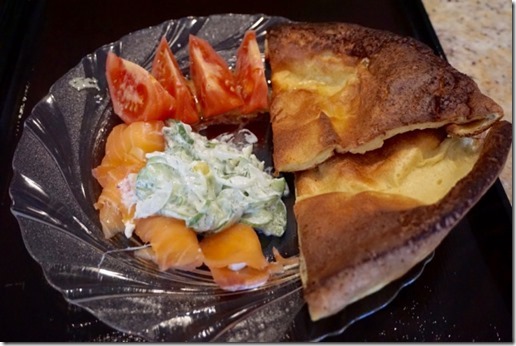
The pancake nicely puffed up.
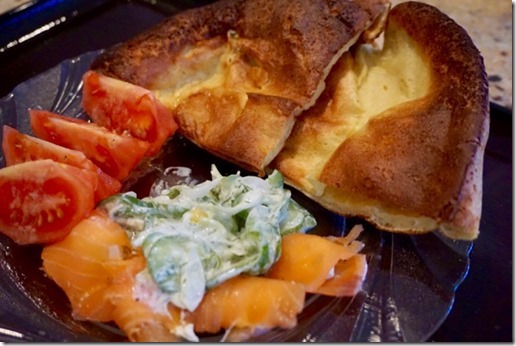
This is rather easy recipe but I will asked my wife to fill in.
Ingredients:
1/2 cup all purpose flour
1/2 cup milk
2 Tbs. sugar
1/4 tsp. salt
2 eggs
1/2 tsp. vanilla
Preheat oven to 425 degrees. Combine the ingredients until moist (first picture below). Melt butter in a cast iron skillet over medium heat (second picture below). Pour batter into the pan and cook 1 minute (do not stir) (third picture below). Transfer pan to oven and cook for 18 minutes.

She also used a heavy cast iron skillet, preheated on medium high flame.

When the batter was poured in the edges bubbles up and made noise.

She placed the skillet in the oven and cooked for 18 minutes. It browned and puffed up nicely.
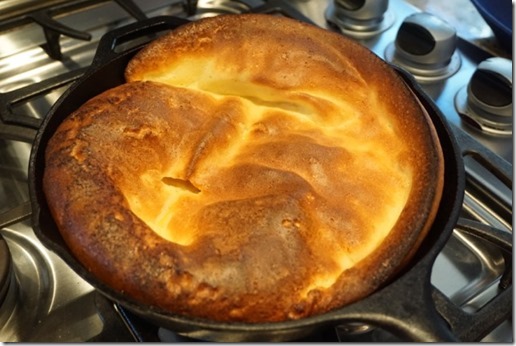
This is after it was taken out from the pan.

She cut it into 4 pieces and we each had two.
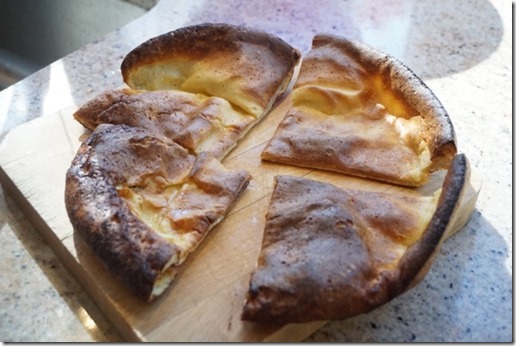
We should make this more often. This is indeed a wonderful pancake for breakfast.
Monday, November 9, 2015
Chestnut flour crepes with honey Ricotta 栗の粉クレープ

This is a rather simple recipe.
Ingredients
1 cup chestnut flour
2 extra large eggs
1 1/4 cups water
2 cups ricotta
1/2 cup honey
2 tablespoons olive oil
Directions
Sift the flour into a mixing bowl and beat in the eggs, 1 at a time. Add the water, whisking until smooth. Allow to stand 15 minutes.
Place the ricotta in a mixing bowl and stir in half the honey.
Heat a 6 to 8-inch nonstick frying pan over medium heat and brush with some of the olive oil. Add 2 tablespoons crepe batter and roll pan to distribute evenly and thinly. Cook until the crepe is firm on the underside and is curling up at the edges, about 1 minute (see below picture).

Flip the crepe and cook on the raw side for about 30 seconds (see picture below).

Continue making crepes until all the batter is finished, stacking each finished crepe on top of the previous one, to keep them warm. To speed up the crepe making process use multiple skillets.
To serve, spoon 2 tablespoons of the ricotta honey mixture in the center of each crepe, roll it up and placed a dollop of honey Ricotta (the original recipe suggested to put honey but that would have been too sweat for us).
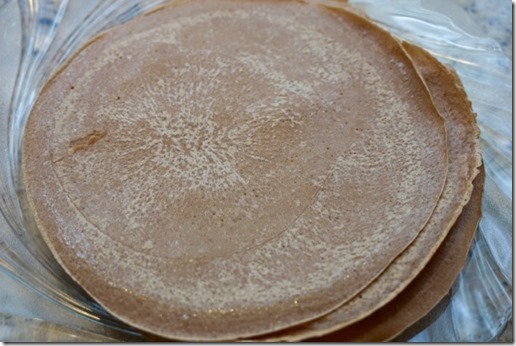
We really liked the honey ricotta. The crepes are a bit dry/brittle (or "bosoboso" ボソボソusing Japanese expression) but had a unique flavor of chestnut. We will not get chestnut flour just to make this crepe in the future, though.
Tuesday, November 3, 2015
Chestnut flour pancake 栗の粉のパンケーキ

For a pancake without any wheat flour, this one came out very fluffy. I also added my chestnut in syrup as a garnish.

I used a small amount of maple syrup but this pancake is rather sweet and may not need any additional syrup.
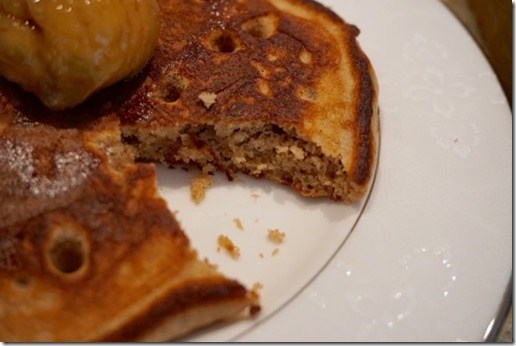
This recipe came from this site. We modified the recipe using our CCK (Common Culinary Knowledge)
Ingredients: (4 pancakes)
- 3 Large Eggs
- 1 Cup Chestnut Flour sifted
- 1/3 Cup Blanched Almond Flour sifted
- 3 Tbs Granulated Sugar
- 2 Tsp double acting Baking Powder
- Pinch of Salt
- 1/4 cup Milk*
- 1 tsp Vanilla Extract
- 1 Tbs. melted Butter
Directions: sift the flours. (This step can not be skipped because the chestnut flour has a tendency to clump and without sifting ends up with several hard lumps). Mix the dry ingredients in a bowl and the wet ingredients in another bowl. Stir the two together. Adjust the amount of milk to get a pourable consistency. Ladle the batter into a hot pan with a little olive oil on the bottom. Cook as you would any other pancake.
*Note: It is important to have a appropriate consistency when making pancake batter. We had to add over 1/4 cup of milk (more like 1 cup) to get a "spreadable" consistency so that the batter would spread in the pan (see below). Probably we could have added more liquid to make it spread to fill the pan. We also omitted "vinegar or lemon juice" included in the original recipe since double action baking powder has it's own source of acid to activate and we judged that "acidic" taste will not be good in the pancake.
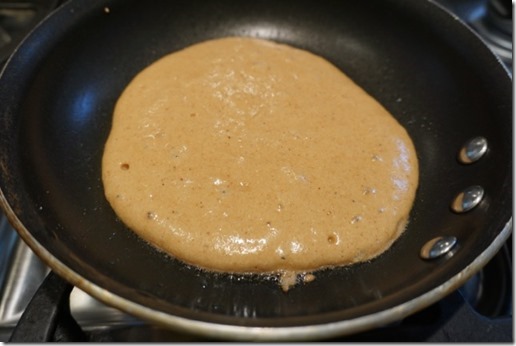
The pancake tends to brown quickly because of the sugar.

This is a great pancake. Despite being gluten-free, it has a very fluffy fine texture. It is slightly sweet and because of the chestnut flour, it has a hint of chestnut flavor as well. Amazingly we were surprised that the pancake seemed to have a “chocolate” flavor. If we did not know how it was made we would have sworn that it included coco powder; although it clearly did not. Because of the special flours, this tends to be a rather expensive pancake to make but we really liked this and we will definitely make it again.
Tuesday, September 22, 2015
Pumpkin pancake パンプキンパンケーキ

Compared to our buttermilk pancakes, these really puffed up much higher. We enjoyed them with small amount of maple syrup and a side of espresso coffee.

The below is a direct quote from the original recipe (italicized) with our modification in parentheses.
Ingredients:
2 cups all-purpose flourInstructions:
2 tablespoons packed brown sugar
1 tablespoon baking powder
1 1/4 teaspoons pumpkin pie spice
1 teaspoon salt
1 can (12 fl. oz.) Evaporated Milk (We made our own
1/2 cup Pumpkin puree
1/4 cup water
1 large egg
2 tablespoons vegetable oil
Chopped pecan (we first roasted and chopped)
Toast about a cup of pecans, mix flour, brown sugar, baking powder, pumpkin pie spice and salt in large bowl. Combine evaporated milk, pumpkin, water (we actually just used regular milk), egg and 2 tablespoons oil in small bowl; mix well. Add to flour mixture. Stir just until moistened; batter may be lumpy. (Stir in chopped pecans.)
HEAT griddle or skillet over medium heat; brush lightly with oil. Pour 1/4 cup batter onto hot griddle; cook until bubbles begin to burst. Turn and continue cooking for 1 to 2 minutes. Repeat with remaining batter. Serve with Pumpkin maple syrup (We just used straight maple syrup).
 This made a total of 10 pancakes. Here is the picture of the 8 remaining pancakes (we ate two). In addition to the pumpkin pie spice called for in this recipe, we did not have evaporated milk either. We have not used or bought evaporated milk for ages. So in addition to making our own pumpkin pie spice, we also made our own evaporated milk. I know what you are thinking; that we have entirely too much time on our hand to do something as silly as that but there were extenuating circumstances. First, we really wanted to make these pancakes, second we had some excess milk that we were wondering what to do with before it went bad. We consulted the internet and found it was fairly easy to make evaporated milk--just simmer a quart of milk until it is reduced by half. (While the process of actually making the evaporated milk was easy, cleaning the pan was not. Trust me, it is worth it to buy it in a can). It took half a day to make and the end product had chunks of "scum" or "membrane" (I assume from the milk protein). We strained the liquid and the end result was fairly thick, deep cream color and tasted pretty good. The funny thing is that this recipe calls for evaporated milk and then adds water. Why not just use regular milk? After all that work we were not about to add water so we used enough regular milk to make the batter of pouring consistency. We have a feeling that just adding milk or a mixture of milk and cream may do just as well as evaporated milk and water.
This made a total of 10 pancakes. Here is the picture of the 8 remaining pancakes (we ate two). In addition to the pumpkin pie spice called for in this recipe, we did not have evaporated milk either. We have not used or bought evaporated milk for ages. So in addition to making our own pumpkin pie spice, we also made our own evaporated milk. I know what you are thinking; that we have entirely too much time on our hand to do something as silly as that but there were extenuating circumstances. First, we really wanted to make these pancakes, second we had some excess milk that we were wondering what to do with before it went bad. We consulted the internet and found it was fairly easy to make evaporated milk--just simmer a quart of milk until it is reduced by half. (While the process of actually making the evaporated milk was easy, cleaning the pan was not. Trust me, it is worth it to buy it in a can). It took half a day to make and the end product had chunks of "scum" or "membrane" (I assume from the milk protein). We strained the liquid and the end result was fairly thick, deep cream color and tasted pretty good. The funny thing is that this recipe calls for evaporated milk and then adds water. Why not just use regular milk? After all that work we were not about to add water so we used enough regular milk to make the batter of pouring consistency. We have a feeling that just adding milk or a mixture of milk and cream may do just as well as evaporated milk and water.We really like this pancake. It has a nice pumpkin and pumpkin spice flavor and is nicely moist and fluffy. The canned pumpkin adds some mild sweetness. The toasted pecans added a nice crunch. These pancakes, like the blueberry pancakes also freeze very well. We took these to work for breakfast and they revived nicely in the microwave oven.






























